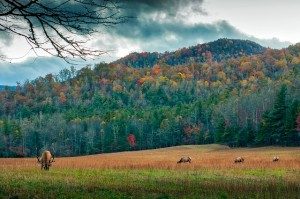Viewing Elk in the Smoky Mountains

Image by David Mark from Pixabay
The Great Smoky Mountains National Park does a wonderful job of preserving and restoring wildlife within its boundaries. In fact, one of the most anticipated activities in the Smokies is watching the park’s exquisite elk herd as it roams and grazes in the wild.
Several centuries ago, elk were commonplace in the area, but they were eliminated due to over-hunting and loss of habitat. It is believed that the last elk in North Carolina was killed in the late 1700s and in Tennessee by the mid-1800s. By 1900, the population of elk in the Smoky Mountains dropped to the point that concern grew among conservation organizations that the species was headed for extinction.
Thankfully, a group of people from multiple organizations (including the University of Tennessee, Rocky Mountain Elk Foundation, Parks Canada, Great Smoky Mountains Natural History Association, Friends of the Smokies, and the U.S.G.S. Biological Resources Division) came together with the goal of returning the majestic elk in the Smoky Mountains where they had once roamed so freely.
In 2001, 52 elk were reintroduced to the Cataloochee Valley, an area in the southeastern section of the Great Smoky Mountains National Park near Maggie Valley, NC. Now, the herd has grown to approximately 200. The elk can often be spotted grazing the Cataloochee’s fields and have even spread into other parts of the Smoky Mountains, getting very comfortable in their new home.
Directions to Smoky Mountain Elk Viewing
The Cataloochee Valley is home to most of the elk in the Smoky Mountains. To get there from I-40, take North Carolina Exit 20, and travel 0.2 miles to Cove Creek Road. Take a right on Cove Creek Road and then travel 11 miles, following the signs and directions into Cataloochee Valley. The trip will take you approximately 45 minutes from the interstate.
Watching elk in the Smoky Mountains is best done in the early morning and late evening. They may also be a bit more active on a cloudy summer day. Early summer is an ideal time to see calves, and September and October are great for the rut (mating season) when bulls gather the cows into larger herds.
Be aware that it is illegal to knowingly come within 50 yards of an elk, so keep your distance and enjoy these beautiful wild animals responsibly with binoculars. It’s a good idea to familiarize yourself with the local rules of viewing elk in the Smoky Mountains to make sure you get the most out of the experience.
True (And Sometimes Weird) Facts About Elk In The Smoky Mountains
- Elk can live as long as 15 years and have an excellent sense of smell and sight.
- Adult males weigh an average of 600-700 pounds, while cows average 500 pounds.
- Even with their large size, a mature bull can run as fast as 40 miles per hour.
- Adults are 7-10 feet long from nose to tail and stand 4.5 – 5 feet tall at the shoulder.
- Elk like to eat grass, acorns, leaves, bark and buds from shrubs and trees.
Only the males have antlers, and they reach widths up to five feet and have been known to grow as much as one inch in a day!
- The size of an elk’s antlers depends on the amount of sunlight the elk gets. (Sunlight causes a boost in testosterone levels, which causes the antlers to grow.)
- The strange bugling sound that the male elk makes during the rut comes from moving both his lips and his nostrils simultaneously – he’s roaring and whistling at the same time!
- Researchers have discovered that the bones in an elk’s ankle make distinct cracking or popping noises when they walk. It is thought that elk use this noise (among other things) to tell when other elk are around.
- Elk can “count” to 10. No, seriously. In observing female elk, scientists found that when she has to choose between a mate with nine antler points or 10 antler points, she’ll almost always select the bull with 10 points. How observant!
